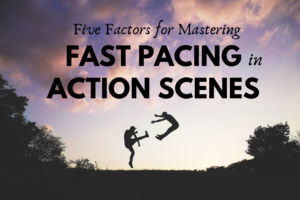
It’s finally time for the big face off and your reader is at the edge of their seat. Having the correct pacing in action scenes is essential. Otherwise your big moment will flop and the worst thing will happen: Your reader will be disappointed. Gasp! There are several tricks to making sure your pacing is on point in this critical moment. Here are my top five tricks:
Factor One: Time Manipulation
The scene itself is usually only a matter of minutes or sometimes even seconds. Think about when Harry and Voldemort clash wands. That was maybe two minutes? But the scene isn’t written like this: Harry and Voldemort pointed wands at each other. The wands blew up. Writing actions scenes requires the author to slow down the clock and stretch out the moment, giving it weight in the plot. This amps up the tension and the interest for the reader.
Another way to manipulate time in action scenes is to try and introduce a “ticking clock.” Yes, this could mean a literal timer before something explodes, but it could also be an imminent consequence if something doesn’t happen within the time frame. Someone or something is coming. Something is falling down. Anything that puts an element of time pressure into the scene.
Factor Two: Including Action + Reaction
We want to give the scene a physical and an emotional punch, a one-two combo. Start with breaking down the scene into smaller actions. What exactly is the character doing? Each motion has more gravitas in this scene so be sure to highlight the actions that are propelling the character forward in the plot. (example: opens the door, feet brush on the rug, a noise comes from the bedroom…)
Next, add in the character’s internal reactions and thoughts. (example: no one is supposed to be here) This confrontation is the culmination of more than just one thing and the character’s mind should reflect that. Increasing the emotion for the character also increases the emotion for the reader. It makes them more attached and rooting for the character to succeed.
Factor Three: Layers of Conflict
Pacing slows down in any scene where there isn’t enough conflict, but it’s especially true during action scenes. Not enough conflict can also make your scene too short or things too easy for your character. The best thing you can do is to absolutely torture your character. Make every single thing that can go wrong happen. If he is about to give a speech in front of a large crowd, make him get a cold the night before. Have him chug a glass of water but not have time to stop in the bathroom. Make him lose all his notes and have his long-lost girlfriend in the crowd. Then have a wardrobe malfunction on stage.
Remember to include the internal conflict as well. Our speech giver can have a crippling fear of failure from all the years his mother berated him for minor mistakes. Make this action scene so heavy with conflict it is almost too much for the reader to handle. We really want to stress the reader out. That way when the upturn comes, it’s that much more exciting.
Factor Four: Zero Fluff. None.
Your big action scene isn’t the place for your character to casually notice the surroundings or have long introspections. Anything extra is going to slow down the pace at this critical moment in your story. It could be information you do need to include in your plot, but it’s probably best to save it for another chapter or scene. So if you haven’t explained why the car is able to fly, the big action scene isn’t the right place to tell the whole backstory involving the fairy powder.
Be merciless when revising your action scene. Ask yourself if the information is an essential part of the current motion or if it can be moved elsewhere. Cut your sentences down as much as possible.
Factor Five: Strategic Structure
This is a critical but often overlooked element of writing fast pacing, the visual structure of the words on the page. The reader’s eyes should fly over the text at the same speed as the story pace. Avoid extended paragraphs and complex sentences. Use short sentences deliberately, creating a punch. When you want the reader to pause, perhaps right before the dog is about to attack, then put in a paragraph that is a little longer than the others. Look at the structure of the words on your page. Use the visual elements of the text itself to enhance your pacing.
Mastering pacing in action scenes takes practice and a focused effort. My best suggestion is to study your favorite action authors and analyze their scenes. How do they use time to create fast pacing? How much of what they write is action versus reaction? What are the layers of conflict? How did they keep the scene lean? What does the structure of the text look like? Studying successful action scenes can help you learn how to build your own.

David Edmonds
Good advice! My heart beat a little faster just reading it. 😃Many thanks.
Arielle Haughee
You made me laugh. Thanks for reading!
Lee Gramling
Good stuff.
Shutta Crum
Excellent! thanks!!
Niki Kantzios
Really valuable reminders. Pace is so important! Thanks.